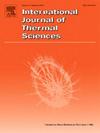非均相湿蒸汽通道泡沫铜的池沸研究
IF 4.9
2区 工程技术
Q1 ENGINEERING, MECHANICAL
International Journal of Thermal Sciences
Pub Date : 2025-07-19
DOI:10.1016/j.ijthermalsci.2025.110158
引用次数: 0
摘要
在常压条件下,对具有工程非均相润湿性的泡沫铜微通道进行了池沸实验研究。采用浸没法和焊接法制备了具有不同润湿性能的泡沫铜微通道。开发了两种特定构型:一种是具有超亲水通道壁和超疏水底表面(SHPiW-SHPoB),另一种是由超疏水通道壁和超亲水底表面(SHPoW-SHPiB)组成。通过实验,系统地评价了润湿性非均质性对沸腾换热性能的影响。结果表明,SHPiW-SHPoB结构的临界热流密度(CHF)为108.2 W/cm2,而SHPoW-SHPiB的临界热流密度为96.7 W/cm2。进一步的实验结果表明,SHPiW-SHPoB配置显著改善了池沸腾特性,表明润湿性模式在能源系统高级热管理方面的潜力。实验结果表明,SHPiW-SHPoB沸腾性能的增强是由于非均质润湿设计实现了汽液两路的有效分离,在低热流密度下促进气泡成核,在高热流密度下抑制气泡聚结。本文章由计算机程序翻译,如有差异,请以英文原文为准。
Pool boiling investigation on copper foam with heterogeneous wetting vapor channels
This study presents a pool boiling experimental investigation of copper foam microchannels with engineered heterogeneous wettability conducted under atmospheric conditions. Copper foam microchannels with spatially varied wetting properties were fabricated using immersion and welding methods. Two specific configurations were developed: one featuring super hydrophilic channel walls with a super hydrophobic bottom surface (SHPiW–SHPoB), and the other comprising superhydrophobic walls combined with a super hydrophilic bottom surface (SHPoW–SHPiB). By experiments, the effects of wettability heterogeneity on boiling heat transfer performance were systematically evaluated. It is found that the SHPiW–SHPoB configuration demonstrates a superior critical heat flux (CHF) of 108.2 W/cm2, compared to 96.7 W/cm2 for the SHPoW–SHPiB. Further experimental results show that the SHPiW–SHPoB configuration offers significantly improved pool boiling characteristics, indicating the potential of the wettability patterning for advanced thermal management of energy systems. The experiments suggest that the enhanced boiling performance of the SHPiW–SHPoB is attributed to the efficient separation of vapor and liquid flow paths enabled by the heterogeneous wetting design, which promotes bubble nucleation at low heat fluxes and suppresses bubble coalescence at high heat fluxes.
求助全文
通过发布文献求助,成功后即可免费获取论文全文。
去求助
来源期刊

International Journal of Thermal Sciences
工程技术-工程:机械
CiteScore
8.10
自引率
11.10%
发文量
531
审稿时长
55 days
期刊介绍:
The International Journal of Thermal Sciences is a journal devoted to the publication of fundamental studies on the physics of transfer processes in general, with an emphasis on thermal aspects and also applied research on various processes, energy systems and the environment. Articles are published in English and French, and are subject to peer review.
The fundamental subjects considered within the scope of the journal are:
* Heat and relevant mass transfer at all scales (nano, micro and macro) and in all types of material (heterogeneous, composites, biological,...) and fluid flow
* Forced, natural or mixed convection in reactive or non-reactive media
* Single or multi–phase fluid flow with or without phase change
* Near–and far–field radiative heat transfer
* Combined modes of heat transfer in complex systems (for example, plasmas, biological, geological,...)
* Multiscale modelling
The applied research topics include:
* Heat exchangers, heat pipes, cooling processes
* Transport phenomena taking place in industrial processes (chemical, food and agricultural, metallurgical, space and aeronautical, automobile industries)
* Nano–and micro–technology for energy, space, biosystems and devices
* Heat transport analysis in advanced systems
* Impact of energy–related processes on environment, and emerging energy systems
The study of thermophysical properties of materials and fluids, thermal measurement techniques, inverse methods, and the developments of experimental methods are within the scope of the International Journal of Thermal Sciences which also covers the modelling, and numerical methods applied to thermal transfer.
 求助内容:
求助内容: 应助结果提醒方式:
应助结果提醒方式:


